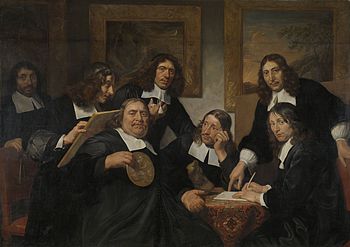Jan de Bray

Jan de Bray (ca.1627, Haarlem - ca. April 1, 1697, Amsterdam) was a Dutch painter.
De Bray was the son and pupil of Salomon de Bray, an architect and a poet. He spent most of his career working in Haarlem, where he was for many years dean of the Haarlem Guild of St. Luke. As in Utrecht most of the painters in Haarlem remained Catholic. Jan de Bray had to cope with death many times. Part of his family died of the plague. His three wives died within a few years of the marriages. His sister Cornelia married Jan Lievens.
Jan de Bray was influenced by Van der Helst and Hals. De Bray's works are mainly portraits, often of groups. He specialised in posing specific figures as historical figures, thus achieving paintings that encompassed the genres of portrait and history painting. The French term for these, "portrait historié" (literally "historicised portrait") is also used in English, sometimes without the accent. Among his finest works are two versions of the Banquet of Cleopatra, using his own family, including himself, as models (Royal Collection, 1652, and Currier Museum of Art, New Hampshire, 1669). The second version has great pathos, as most of those depicted had died in the plague of 1663-4.[1]
As a key figure in Dutch Classicalism of the seventeenth century, De Bray, like his contemporaries, drew inspiration from the same ancient writers and sources as the Italian artists of the fifteenth century. Working in the classical tradition, these artists emphasised harmony, proportion and balance in their compositions in order to present an idealised beauty.[2]

In 1689 he was declared bankrupt as a Haarlem citizen and he moved to Amsterdam, where he stayed until his death. He was buried in Haarlem on April 4 1697.
References
- ^ Christopher Lloyd, Enchanting the Eye, Dutch Paintings of the Golden Age, pp. 49-52, Royal Collection Publications, 2004, ISBN 1902163907.
- ^ Bolton, Roy (2009). Old Master Paintings & Drawings, London, Sphinx Books, pp. 142-147. ISBN : 978-1-907200-01-4
External links
- Murray, P. & L. (1996). Dictionary of art and artists (p. 65). London: Penguin Books. ISBN 0-14-051300-0. (For details see: Sources)
- Jan De Bray and the Classical Tradition at the National Gallery of Art, Washington - 16pp pdf exhibition brochure
- Entry for Jan de Bray in the RKD, the Netherlands Institute for Art History
